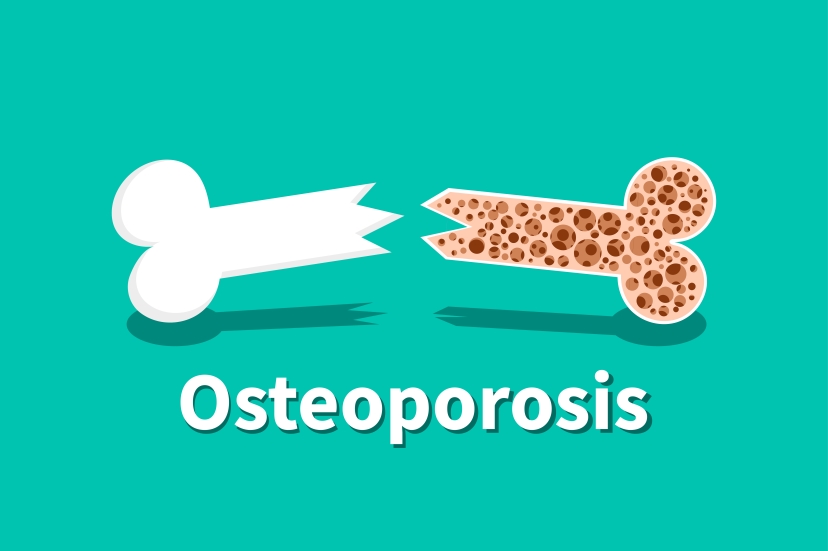Osteoporosis and Prevention and Treatment
Osteoporosis is frequently known as the “silent danger” because bone density loss is often not accompanied by displayed symptoms. A report by the World Health Organization (WHO) found that there are increasing numbers of osteoporosis patients worldwide and this has become second leading public health problem after cardiovascular disease.
Bone density is greatest from childhood to adulthood, but after 30 years onward, bone density gradually decreases, whereby the rate of bone degeneration is faster than the rate of bone generation, leading to more fragile and weaker bones that become osteoporosis.
Osteoporosis causes various symptoms such as back pain, spinal collapse, a hunched back and shorter stature and brittle bones of the limbs that easily break after receiving only minor impacts.
Risk Factors for Osteoporosis
In terms of risk factors, osteoporosis occurs more commonly in women than men, especially elderly female (> 65 years old) who are Asians with small builds, who experience menopause before 45 years of age and people who have prior history of breaking of brittle and fragile bones and family history of osteoporosis.
Additionally, Thai people are at risk of developing osteoporosis by not meeting the recommended daily intake of calcium, by smoking or by regularly consuming alcohol, all of which are risk factors for developing the disease.
Patient Care… and Preventing Progression of Osteoporosis
There are many ways to prevent osteoporosis. For example, consumption of foods that contain calcium, Vitamin D and various minerals can help delay loss of bone mass. Regular and appropriate exercise helps to improve balance, and renovating the home for safety can reduce risk of falls. You can also reduce other risk factors such as smoking and heavy alcohol consumption.
Treating Osteoporosis by Taking and Injecting Medications
Today, there are many ways to treat osteoporosis, for example, lifestyle changes, exercises and medications, which include many types of drugs, including bone resorption inhibitors, hormone therapy and taking of various nutritional supplements. However, treatment requires time and can produce side effects in patients.
For the most part, doctors consider treatment along with the characteristics of the patient. For example, when taking an oral bone resorption inhibitor, the patient has to take it while on an empty stomach and sit straight for 45 minutes. Failure to strictly follow this instruction can cause the drug to work less effectively than it should. Meanwhile, your doctor might consider other kinds of drugs, for example, by giving you an injection every 3 months to inhibit bone resorption, which is a convenient way to manage patient medication. Patients who receive the full doses of this medication will be safer and experience fewer side effects from irritation in the digestive system. The bone mass increases more effectively than when taking the oral medication. This can ensure that the treatment is effective.
Exercise for Osteoporosis Patients
Regular exercises aimed at increasing bone mass should be weight-bearing exercises, because bones are organs that are constantly changing, and bones that experience mechanical force will modify bone tissues consistently with that force.
In addition, if the muscles exert a lot of force upon the bones, the bone cells will be able to generate more bone tissues than resorption, whereas less force upon the bones will lead to a greater rate of resorption. Consequently, exercises aimed at increasing bone mass require that of respective bones bear weight. If you are currently suffering from osteoporosis, we recommend that you exercise for half an hour each day as follows:
1. Upper back muscle exercise: Lie down flat with a pillow supporting the waist. With the hands placed to the sides of the torso, perform the exercise by raising both the head and the chest while pulling the shoulders together.
2. Abdominal muscle exercise: Lie down flat with the knees raised and the hands to the sides of the torso and then perform the exercise by raising the head while flexing the abdominal muscles.
3. Lower back muscle exercise: Raise one foot until the knee is bent and then continues raising until the thigh is on the same plane as the torso.
4. Upper back muscle exercise: Pull both arms toward the back.
5. Abdominal exercise: Lie down horizontally with the knees raised. Exercise by flexing the abdominal muscles while pressing the back to be horizontal with the floor and then raise the hip up.
You may find our specialist here at Orthopedic Institute and Diabetes and Endocrine Center, Phyathai 2 Hospital
Phyathai 2 Hospital
International Correspondence Center
Tel: +66-2617-2444 ext. 2020 or 2047 E mail: onestop@phyathai.com
 @pt2_inter
@pt2_inter
 Phyathai 2 Cambodia
Phyathai 2 Cambodia
 PT2Chinese
PT2Chinese
 phyathai2inter
phyathai2inter
